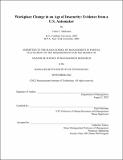Workplace Change in an Age of Insecurity: Evidence from a U.S. Automaker
Author(s)
McKenna, Claire C.
DownloadThesis PDF (348.9Kb)
Advisor
Osterman, Paul
Terms of use
Metadata
Show full item recordAbstract
What accounts for the low adoption of high performance work practices in the U.S.? This study explores a political explanation: their survival depends on the cooperation of different social actors in organizations. Through a qualitative interview study of two underused work reforms at a U.S. auto plant, I explore how interpretations of workplace change vary across interest groups, with the goal of helping to explain what limits diffusion broadly. The first reform permits certain skilled employees, as team members, to cross job boundaries. The second reform redistributes job tasks from skilled to production employees. In insecure contexts, the concepts of opportunity and threat are a useful framework for understanding actor responses to change. While teams were most commonly viewed as opportunities, interpretations of task redistributions were mixed. While non-skilled national union representatives viewed them as an opportunity for the majority production workforce to share in the gains of technological change, skilled representatives viewed them as threats, and resisted them. Adoption of both reforms seemed to depend on endorsement of local skilled leadership. This study contributes to the small literature that uses a political framework to understand implementation of work organization changes. Further, it provides insight into other forms of insecurity informing actor responses to change--not job insecurity per se, but longer-term labor market insecurity rooted in declining occupational status. This has implications for which complementary measures might spark greater workforce commitment in firms trying to advance work reforms. Further, this study highlights enduring sources of leverage and occupation-based conflict within traditional U.S. labor unions today. Finally, it contributes to future of work discussions by highlighting the bureaucratic structures and group interests with which firms adopting new technologies contend, suggesting that job or skill outcomes of technological change are not fixed.
Date issued
2022-09Department
Sloan School of ManagementPublisher
Massachusetts Institute of Technology